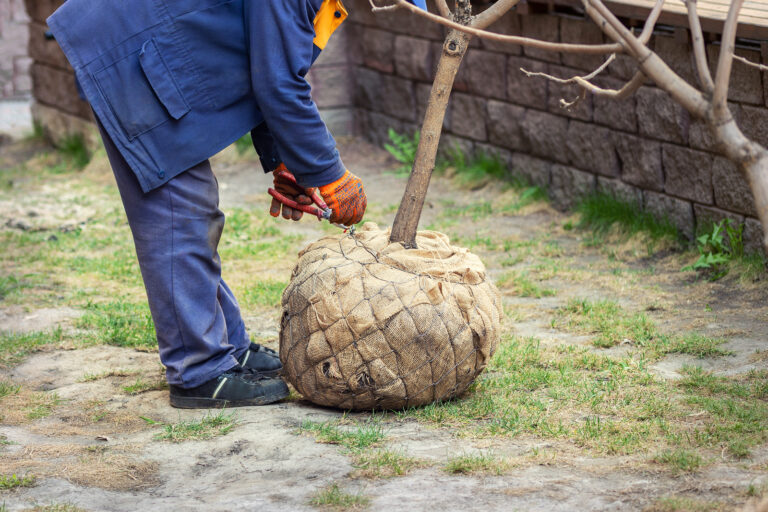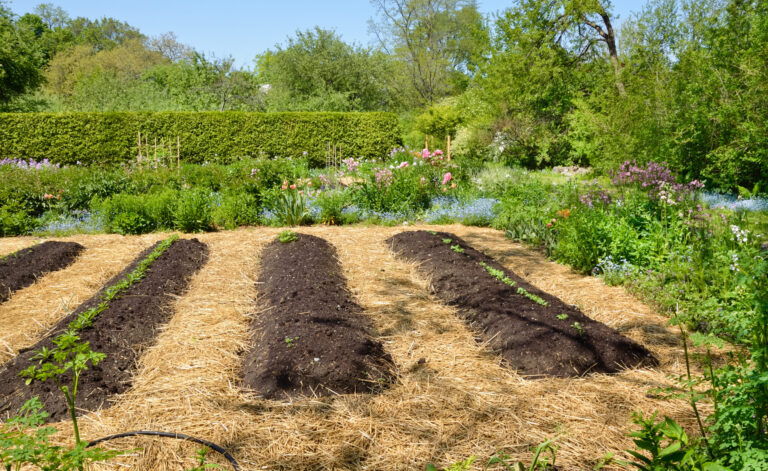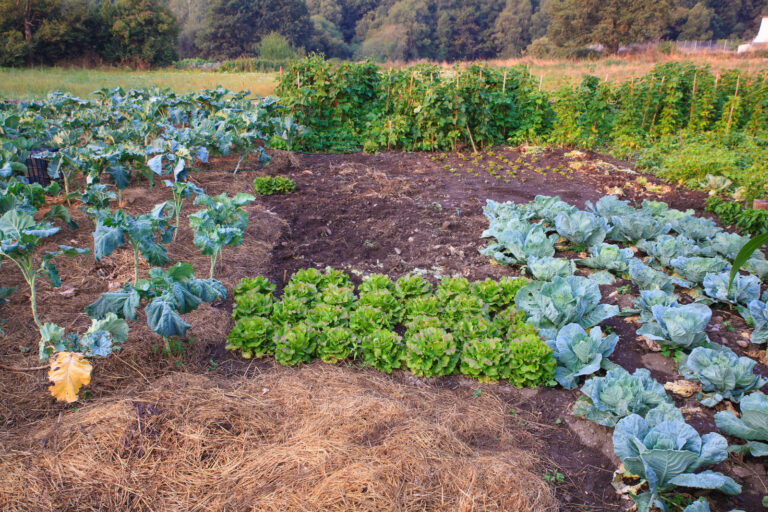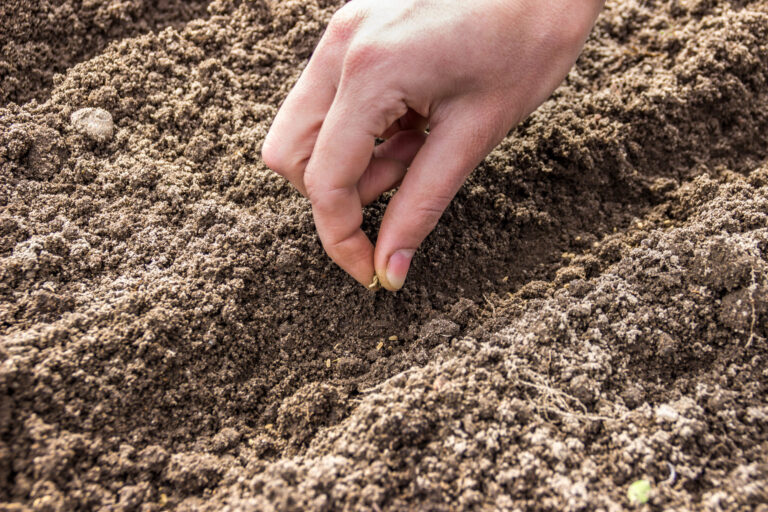January Vegetable Garden
January is the coldest month of the year in the northern hemisphere. This is the month to get seed catalogs and begin planning the spring garden. Beware of false spring days. Check with the weather service or local cooperative extension for your area’s average last frost date–the last expected frost and the start of outdoor sowing season; plan ahead now for indoor seed starting and planting out.
There is a lot to do in the garden–or for the garden–in January. You may want to print out this list of to-dos and get started as the weather permits.
Of course, if you live in a warm- or mild-winter region, you can start sowing and planting in the garden this month. You’ll see the planting lists for your region below.
If you live in a cold-winter region, double-check your average last frost date and note the number of weeks until you can set seedlings into the garden. If your last average frost comes in mid- to late April, you may want to start many of your crops indoors before the end of this month.
Wherever you live, January is one of the best months to read vegetable gardening books and plan your spring and summer gardens. In light of last year’s experience, what changes will you make in the new season? Start jotting down your ideas and make sowing and planting maps.
January also is a good month to clean and sharpen tools and service equipment.
In mild-winter regions where the ground is not frozen, January is the start of the new growing year.
Harvest to table buyer’s guide:
January harvest
Here is list of some of the vegetables and fruits that will come to harvest in January: Vegetables: beets (beetroot), broccoli, Brussels sprouts, carrot, celeriac, chilies, Chinese cabbage, corn salad, kale, lettuce, parsnip, peas, peas, purslane, radish, rutabaga (Swede), spinach, turnips, witlof chicory. Fruit: late apples, avocadoes, banana, feijoa, guavas, grapefruit, kiwifruit, kumquat, limes, early mandarins, olives, oranges, passionfruit, and tangelos.
First of season harvest: Grapefruit, oranges, lemons, kiwi, red cabbage, scarlet turnips, winter broccoli.
Peak of season harvest: Almonds, arugula, beets, broccoli, cabbage, cauliflower, carrots, chard, chipotles, collards, decorative corn, celery root, dried fruit, dried garlic and onions, herb starts, horseradish, kale, leeks, leaf lettuce, mushrooms, dried onions, mandarin oranges, pistachios, pomegranates, pomelos, potatoes, olive oil, olives, navel oranges, radishes, raisins, salad mix, scallions, sorrel, spinach, sweet potatoes, squash (delicate, butternut, Kabocha, acorn, tangerines, hydroponic tomatoes, turnips, winter squash, yams, fresh herbs including rosemary, oregano, bay leaves.
End-of-season harvest: Apples, apple cider vinegars, red and white Jerusalem artichokes, bok choy, celery, chestnuts, cilantro, chives, garlic, red flame grapes, pineapple guava, mint, parsley, persimmons, potatoes, pumpkins, tarragon, walnuts.
January planting
Cold northern regions–Zones 3-6: Vegetables: artichokes, asparagus crowns, broad beans, cress, lettuce, onion, peas, spinach, turnips. Herbs: garlic.
Temperate Regions–Zones 7-9: Vegetables: artichoke suckers, asparagus crowns, beets, broad beans, cabbage, carrots, cress, kohlrabi, lettuce, mustard, onion, parsnip, peas, potato tubers, rhubarb crowns, salsify, Swiss chard (silverbeet). Herbs: chamomile, garlic, marigold, parsley.
Subtropical and Tropical Regions–Zones 10-12: Vegetables: asparagus crowns, beans, beet (beetroot), broad beans, cabbage, cape gooseberry, capsicum, carrots, celery, chayote (choko), Chinese cabbage, cress, cucumber, endive, fennel, lettuce, marrow, melons, mustard, parsnip, peas, potatoes, pumpkin, radish, rhubarb crowns, salsify, shallots, Swiss chard (silverbeet), spinach, spring onion, strawberry runners, sweet corn, sweet potato, tomato, zucchini. Herbs: angelica, basil, borage, caraway, chamomile, celeriac, chervil, chives, coriander, dill, garlic, hyssop, lemon balm, marjoram, oregano, parsley, salad burnet, thyme.
January to-dos
Rhubarb. Rhubarb can be planted this month. Set roots 3 feet (.9m) apart in soil rich in aged compost or aged manure. Root tops should be set about 1 inch (2.5cm) below soil level. Place a 3-inch (7.6cm) layer of compost over each root after planting. Do not harvest newly planted rhubarb in the first season rather let these perennial roots become well-established for an ample harvest next year.
Established rhubarb can be fed in January. Again add a 3-inch (7.6cm) layer of well-aged compost to the bed. To encourage early growth, cover rhubarb plants with a large upturned box or bucket.
Rotating crops: In addition to new beds, January is the time to plan crop rotations and succession plantings for the upcoming season. Tomatoes, beans, cucumbers, and potatoes will benefit from a three- or four-year crop rotation. Rotating crops will keep many pests and diseases from getting started in your garden.
Seed catalogs: If you don’t have the new seed catalogs, get them now or begin searching the internet for new vegetable varieties you’d like to grow this next spring. Apart from the old favorites which are usually easy to come by, order varieties–the ones you’ve never grown before–early. Many regional and hard-to-find seed growers have limited supplies.
Seed viability: If you have seeds on hand from past years, now is the time to test their viability. Most seeds will last 3 years if stored in a cool, dry location. To test seed viability place a few seeds on a wet paper towel for several days to see if they germinate.
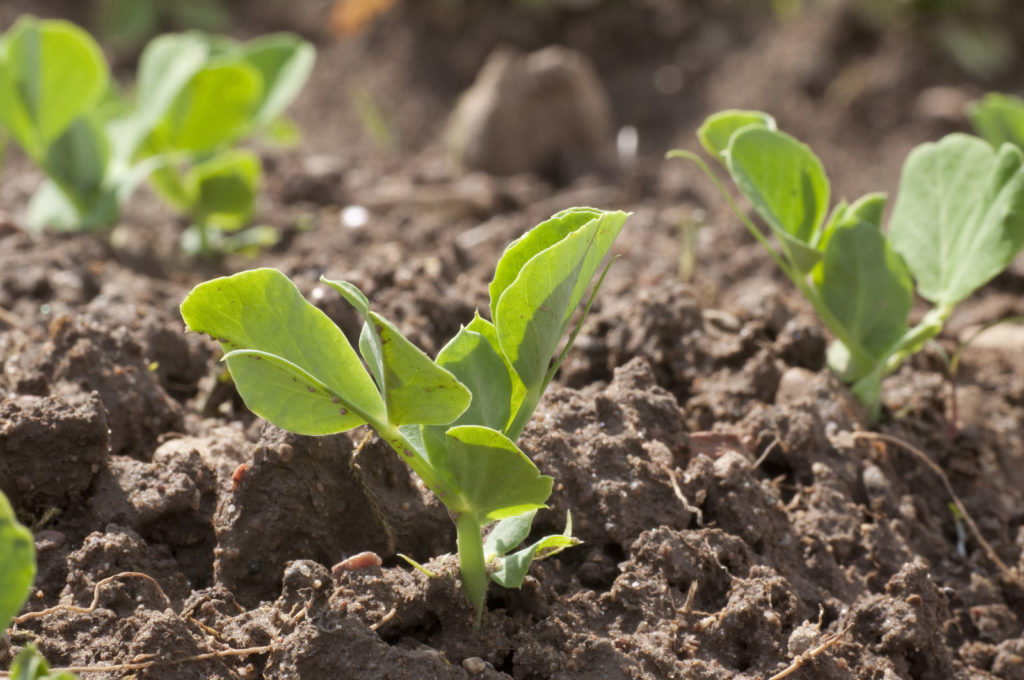
Peas. Sow peas this month in regions where the soil does not freeze and there is minimal frost. For early planting, choose round-seeded varieties. Sow seeds 2½ inches (6cm) deep and 2 inches (5cm) apart in three rows for a nice crop. Place plastic tunnels or cloches over the rows. These peas will be ready for picking in May or June.
Broad beans. Like peas, broad beans–also called fava beans–can be sown now. Sow in rows 7 inches apart with 6 inches (15cm) between rows.
Shallots. Shallot bulbs can go in the ground this month or next month where the soil is well-drained and not too wet. Set bulbs 9 inches (22cm) apart in rows 12 inches (30cm) apart. The bulbs should go into shallow drills with the tips just peaking up at ground level. Do not press the bulbs into the soil which could damage them. In cold regions, wait until the end of February to set out shallot bulbs.
Cool-season vegetables. Where the ground is not frozen, cool-season crops can be planted this month. Seedlings or starts of broccoli, Brussels sprouts, cabbage, and cauliflower can be set in the garden. Be sure to have row covers or portable plastic tunnels at the ready to protect crops from heavy frosts. Where the soil is not too wet sow seeds of celery, kale, kohlrabi, mustard, lettuce, and mixed greens. Also sow the seed of root crops: beets, carrots, radishes, and turnips. Read about Cool-Season and Warm-Season Crops

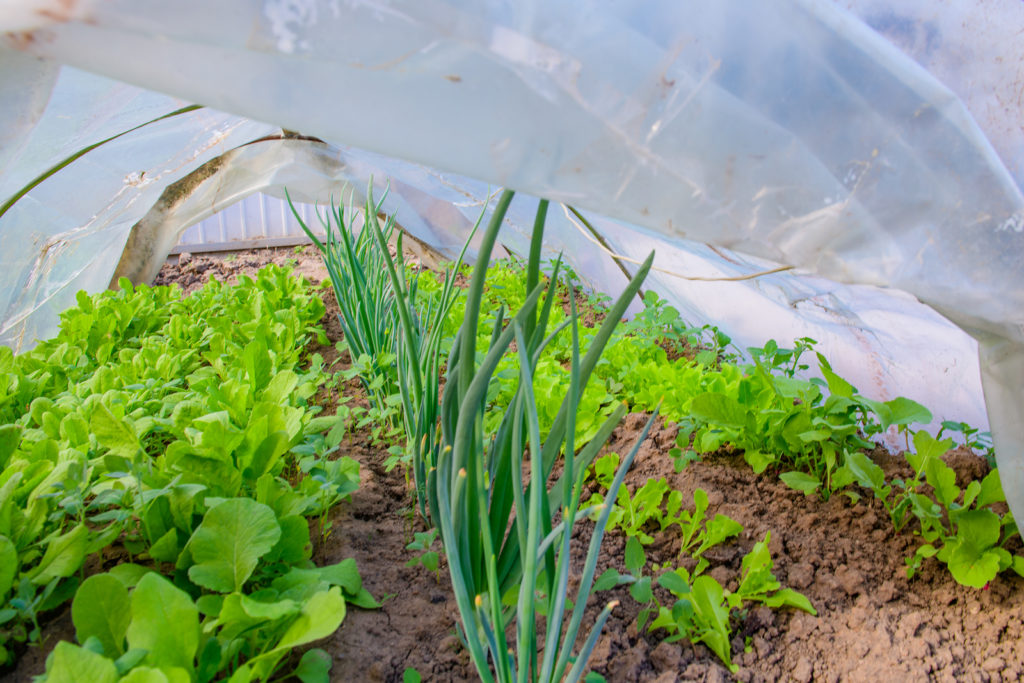
Plastic tunnels and row covers. Early season crops started or transplanted to the garden must be protected from frost and freezes. In Zones 9-11, have row covers and portable plastic tunnels ready to place over early-season crops. In colder zones, plant under a plastic tunnel or in a cold frame to protect crops from cold temperatures.
Bare root vegetables. Perennial vegetables such as asparagus, garlic, onions, potatoes, rhubarb, and shallots should be ordered for planting now. In regions where the ground does not freeze these crops can be planted this month.
Citrus trees. Fertilize citrus trees in January if you live near the coast or in a frost-free area. If you live in a region that experiences frost hold off fertilizing citrus until March. Granular fertilizers break down and feed trees over time.
Fruit trees. Deciduous fruit trees can be dormant sprayed in January. Dormant sprays include horticultural oils, lime sulfur, and copper. Horticultural oils will control overwintering insects and mites. Lime-sulfur and copper sprays will control some fungal diseases such as peach leaf curl, brown rot, and shothole fungus.
Apricot trees. Apricots flower early so don’t spray them with lime-sulfur which can burn the blossoms and damage the year’s crop. Use a copper spray to control apricot diseases.
Peach trees. Peaches that can be infected with leaf-curl fungus (causing leaves to pucker and turn yellow and red) should be sprayed with lime sulfur three times. The first application should come when trees first drop their leaves in November or December. The second and third applications should come in January–early in the month and again late in the month.
Grapes. Prune grapes in January to ensure a good crop later this year. Grapes can be “cane” or “spur” pruned. Grapes require regular pruning to reduce disease and encourage growth and good fruit production.
More January vegetable garden to-dos
• Harvest continues in mild-winter regions: harvest winter cabbage, Brussels sprouts, kale, chard, parsnips, salsify, leeks, and spinach.
• Harvest sunchokes: make sure to lift every piece of the tuber. Store tubers in a paper bag in a cool, well-ventilated shed or garage.
• Force rhubarb: cover the crowns with a deep layer of leaves or leaf molds, and then cover them with a pot or a box to exclude the light.
• Force Belgian endive roots quickly in the basement or a dark place at this time of year.
• Plant patrol: Take a tour of the garden this month. Make sure all mulches are in place. Check perennial plants to see if freezing and thaws have lifted plants out of the soil. Press these plants firmly back into place.
• Tools and supplies: Check garden tools in storage. Sharpen and oil blades, oil wooden handles, and make sure tools are staying dry. Replace tools that are worn out before the season gets going. Be sure to check stakes, labels, pots, flats, spraying and dusting materials, and fertilizers.
• Soil preparation: Most garden soils will benefit from the addition of animal manure at least once every two years. Aged cow manure can be broadcast across the garden when the snow has cleared. Figure about 500 pounds of aged-manure per 1000 square feet of garden. Applied early, manure will find its way into the soil without your turning the soil. If planting time is near in your region, spread well-aged compost over the planting beds before planting. If you applied a sheet-compost last fall, turn it under at least three weeks before planting.
• Complete digging or turning the garden where the soil is dry and can be worked. Leave the ground rough until planting time.
• Test you soil. Lime if your soil needs it.
• Mulch: Winter vegetables can be mulched with unsifted compost. It will keep down winter weeds, conserve heat, and provide nourishment.
• Compost pile: On a mild winter day, turn the compost heap. Add a layer of soil on top. Place a plastic tarp or lid on the pile to protect it from heavy rains.
• Cold frames and greenhouses: Keep cold frames well-covered during mid-winter cold spells. Use tarps or heavy plastic to cover the frame or place straw under the sash. In warm spells, ventilate the frame during sunny hours and close it up again before temperatures fall toward evening. If snow is covering the frame, that will work to insulate the inside. Check plants growing under glass regularly and pick off any dead or dying leaves before they start to rot.
• Potatoes: Plant early potatoes in pots in a greenhouse or cold frame to produce a very early crop.
• Early seed starting: Where there are just 8 weeks to go before the last frost in spring, start seeds of tomatoes, peppers, and eggplants indoors. Also, start sweet potato sprouts.
• Seed sowing cell packs, trays, and boxes: Make sure seed trays and pots are perfectly clean. Clean previously used cells and trays in a 10 percent bleach solution and rinse–check to make sure there are sufficient drainage holes.
• Start sowing seeds of hardy cabbage family crops and onions indoors. These are usually the first to go into the garden in early spring. Seedlings started indoors require uniform moisture and light during the early part of life.
• Containers and pots: Begin cleaning out pots and containers for spring planting. Scrub out loose soil and clean and disinfect pots in a 10 percent bleach solution.
• Bareroot fruit trees and berries: Purchase or order bare-root fruit trees and vines for spring planting. In mild regions, plant bare-root, balled-and-burlapped, and container-grown trees, shrubs, and vines.
• Check stakes and supports for fall-planted trees. Be sure stakes are secure and haven’t been loosened by rain, snow, or wind.
• Protect fruit trees and shrubs from rabbits and other rodents: check tree guards and tree wraps.
• Protect citrus and cover fan-trained trees with spun poly covers.
• Prune apples and pears on clear days: cut out crossing, and dead or diseased branches. Do not prune cherries, peaches and nectarines, plums, and damsons in cold regions yet. Wait until late winter when the weather has warmed more so that pruning wounds heal more quickly. In mild-winter regions, prune these trees as soon as flower buds are recognized.
• Apply dormant oil sprays if the temperature is warmer than 40°F for at least twenty-four hours. Complete spraying and pruning before the sap begins to flow in February or March. Spray peaches, nectarines, and almonds with a copper-based fungicide to prevent the attack of peach-leaf curl.
• Berries, brambles, and grapes: Prune berries, brambles, and grapes on mild, sunny days. Remove a third of old vines and all undergrowth. New vines: reduce all leading shoots by half. Check and repair wires and other framework supports used for cane fruits. Apply a mulch of well-rotted manure or compost around the bases of gooseberries. Sow alpine strawberries indoors.
• Planting in January: Mild-winter regions sowing and planting: In dry and warm to mild regions, prepare the garden for planting; where necessary; water planting beds well to flush out built-up salts. Sow cool-season vegetables and herbs indoors or in a cold frame to plant out next month. Direct sow cool-season crops where the winter is very mild: beets, carrots, lettuce, radishes, and spinach. Plant asparagus and artichoke roots and rhubarb crowns. Also set out horseradish. Where there is no threat of snow, direct sow early peas and broad beans under cloches and set out onion sets and early vegetable starts such as cabbage, cauliflower, and broccoli. In warm sandy soil, potatoes may be planted.
Regional gardening suggestions
These suggestions are divided into 4 major geographical areas: North and East and Midwest (zones 2 in the northernmost areas to 6 along the coast), the South (zones 7 in the north to 10 in the far south), the Southwest and California (zones 7 in the coolest areas to 11), and the Northeast (zones 5 in the highest elevations to 8 along the coast).
• North and East and Midwest. Plan the spring and summer vegetable gardens. Mulch strawberry plants when the ground freezes. Force rhubarb and Belgian endive. Grow mushrooms. At the end of the month, sow early cabbage, cauliflower, celery, peppers, radishes, and tomatoes in hotbeds, cold frames, and greenhouses.
• South. Strawberries and berries can be planted in mild regions. Set out roots, crowns, and sets: asparagus, Bermuda onions, and rhubarb. Plant beets, carrots, garden peas, lettuce and greens, mustard, radishes, and turnips in most regions. By the end of the month in all regions: sow beets, broccoli, cabbage, carrot, cauliflower, chard, endive, kale, kohlrabi, lettuce, leek, onion, parsley, peas, potatoes, radish, spinach, and turnip. Use smooth-seeded varieties for early planting
• Southwest and California. Asparagus, artichokes, horseradish, and rhubarb can be set out now. In warm soil plant potatoes. Make new strawberry beds. In mild-winter regions where the soil can be worked sow early-maturing seed crops by mid-month: beets, broccoli, Brussels sprouts, carrots chard, endive, green onions, kale, kohlrabi, leaf lettuce, mustard, parsley, radishes, rutabaga, spinach, and turnips. Divide and reset herbs. Divide chives.
In frost-free, warm-winter locations sow now beans, cantaloupes, cucumber, muskmelon, peppers, and tomatoes. Seeds can be germinated in a cold frame and then transplanted out.
• Northwest. Toward the end of the month seed onions, early potatoes, and carrots in sandy soil. In cold regions make cold frame and hotbed seedings of cool-weather crops at month’s end.
January Southern Hemisphere vegetable garden
January brings the summer holidays in the Southern Hemisphere. It’s midsummer in Australia, New Zealand, South Africa, Argentina, Uruguay, and Chile.
Australia Day is coming on January 26. Australia Day is the official national holiday of Australia. On that day in 1788, British Admiral Arthur Philip and his fleet of 11 ships arrived in Sydney Cove and set up the Colony of New South Wales. Civic celebrations, music festivals, cricket matches, and fireworks will be the order of the day.
This is the hottest month of the year in the Southern Hemisphere. (This year has been particularly rough in much of Australia where a prolonged drought has emptied many reservoirs and generated more bushfires than usual.) In the more tropical areas of the northern Southern Hemisphere, the rainy season should begin soon.
Here is a planting schedule by region for the southern hemisphere in January:
Temperate regions: Vegetables: beans, beets (beetroot), broccoli, Brussels sprouts, cabbage, carrots, cauliflower, celery, celeriac, chicory, cress, cucumber, kohlrabi, leeks, lettuce, marrow (courgette), melons, mustard, okra, spring onion, potato tubers, pumpkin, radish, rhubarb crown, Swiss chard (silverbeet), squash, sweet corn, sweet potato, tomato, zucchini. Herbs: fennel.
Tropical and subtropical northern regions: Vegetables: artichoke suckers, beans, broccoli, cabbage, cape gooseberry, capsicum (sweet pepper), celery, Chinese cabbage, cress, cucumber, eggplant, fennel, lettuce, marrow, melons, mustard, okra, parsnip, peas, pumpkin, radish, rhubarb crowns, silverbeet (Swiss chard), spring onion, squash, strawberry runners, sweet corn, sweet potato, tomato, zucchini.
Cooler southern regions: Vegetables: beans, broad beans, broccoli, Brussels sprouts, cabbage, carrots, cauliflower, chicory, cress, endive, kohlrabi, leeks, lettuce, spring onion, parsnip, radish, rhubarb crowns, salsify, shallots, Swiss chard (silverbeet), turnip. Herbs: borage, chervil, chives, dill, parsley.
January Harvest Schedule for the Southern Hemisphere:
Here is a roundup of vegetables and fruits ready for harvest during January in the Southern Hemisphere:
Vegetables: Beans, beet (beetroot), carrot, corn, cucumber, lettuce, pumpkin, Swiss chard (silverbeet), tomatoes, turnip, zucchini.
Fruit: early almonds, early apples, late apricots, avocado, blueberries, cape gooseberries, late cherries, gooseberries, early grapes, lemons, loganberries, mulberries, nectarines, Valencia oranges, passionfruit, peaches, plums, raspberries, strawberries.
More about January
January is the coldest month of the year in the northern half of the world. The Norseman named January for Thor, their god of thunder and storms. The Anglo-Saxons called it Wolfmonth because the wolves came into the villages in the dead of winter to search for food.
Legend says that the Roman emperor Numa Pompilius added January and February to the 10-month Roman calendar in about 700 B.C., and that Julius Caesar added the 31st day to January in 46 B.C.
January is named after the Roman god Janus, the god of doors and gates and of beginnings and endings. Passing through a door or gate can be a metaphor for starting something new and leaving something behind, an ending and a beginning. Janus had two faces; one looking ahead and one looking back.
The Romans often prayed to Janus when they were about to start something new. Janus came first among the Roman gods in prayers.
The tradition in ancient Rome was to give friends and family branches of bay and palm trees at the beginning of January. As the ancient Romans used to say, the first month of the year is a time for “turning over a new leaf.”
Also of interest:
January Vegetable Garden Zone-by-Zone
Garden Planning Books at Amazon:



